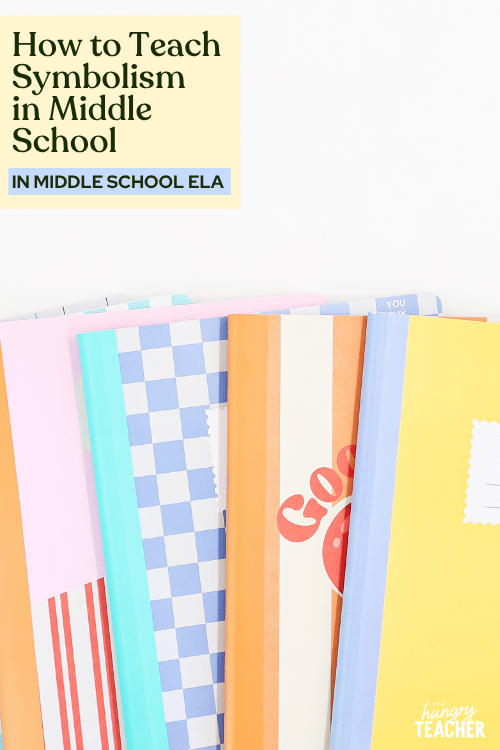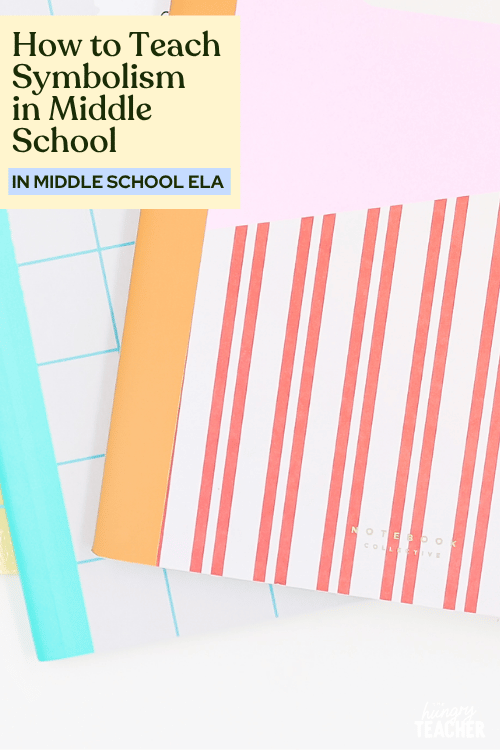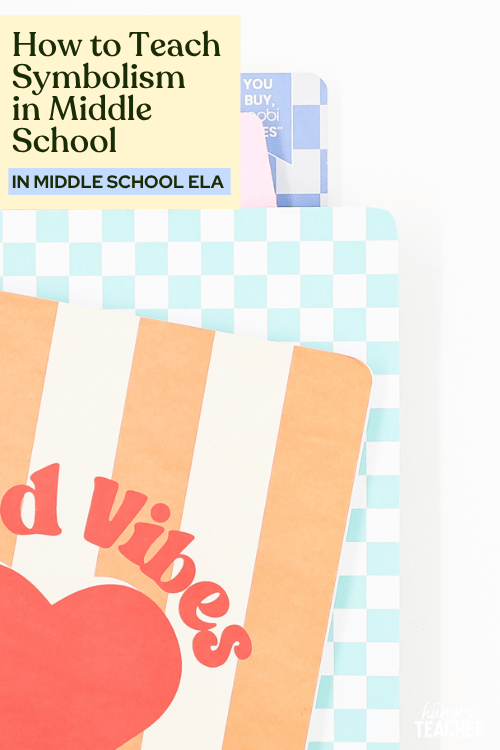hey friend!
I'm Martina.
I provide practical, time-saving strategies that actually work—so you can engage your students, teach effectively, and reclaim your time from the exhausting planning-grading cycle.
Browse Our ELA Resources
How to Teach Symbolism in Middle School
There is the running joke about English teachers that we love to dig for meaning in a text, when there simply isn’t one. This joke always makes me laugh, but it also reminds me of how our students must feel a lot of times, especially when we’re teaching symbolism.
When we, as teachers, look at a text, it is fairly easy for us to find the author’s craft or symbolism present. It seems to stand out. It’s like watching a movie, and the camera zooms in on an object – we know this is going to be important later.
For our students, they sly camera pans or repetitive words can easily go right over their heads. They aren’t used to noticing these types of elements in literature. When teaching symbolism, I want you to keep this in mind. Today, we are going to talk about how to teach symbolism to middle schoolers, so that over time, students can recognize and analyze symbols.

WHAT IS SYMBOLISM?
Symbolism is the use of a symbol by the author to represent another idea. Symbols can be anything from colors, objects, locations, people, and more. Often, symbols reappear throughout the story. There are certain symbols, like colors, that can carry a similar meaning from text to text. Red, for example, often represents love and passion, or on a darker note, blood and death.
What makes symbolism tricky is being able to identify it when you see it. Sometimes the color red represents love. Sometimes, it is just the color red! This can be extra confusing for students.
HOW DO I HELP MY STUDENT KNOW WHEN SOMETHING IS A SYMBOL AND WHEN IT ISN’T?
This is probably the trickiest part of teaching symbolism. After you introduce what symbolism is to students, there will be several who will label every color and object they see in the text “symbolism”. To help students best identify a symbol in a text, how they think about a few key questions:
- Does this object / color / place appear more than once in the story?
- When this “symbol” appears, what is happening in the story?
- At what point in the story does the “symbol” appear? (rising action, climax, falling action, etc)
If the symbol is repetitive or appears at the turning point in the story, then it is probably a symbol. If the “symbol” only appears once, doesn’t show up at a significant moment in the story, or seems to place no role in the story’s plot, then it likely isn’t a symbol.

HOW DO I TEACH SYMBOLISM TO MY STUDENTS?
We’ve talked about the challenges with symbolism, but don’t let that deter you from jumping in. With enough practice and guidance, students can master symbolism.
To begin your introduction to symbolism, give your students a list of common symbols. There are many colors and objects that are commonly used to represent something. Having a list of common symbols can help students take the first step into symbolism.
Then, choose a text to read with students. I would begin with a text that you know has a clear symbolism or a symbol that is common. This will give students practice while they are still new at finding and identifying symbolism.
After your students have practiced locating symbols in afew easier texts, it’s time to present students with texts where the symbol is less obvious, or the meaning of the symbol is not common. Again, as you read, ask students a few key questions to help them locate the symbol:
- What object, color, person, or place is being repeated throughout the text?
- What object, color, person, or place appears during heightened moments of the text?

HOW DO I KNOW MY STUDENTS HAVE MASTERED SYMBOLISM?
Overtime, students will be able to recognize symbols with more ease. At that point, it’s time to push students beyond recognition and just simply identification of what a symbol represents. We want students to begin thinking how the author uses that symbol and why. We also want them to think about the purpose of the symbol.
When students begin diving into these deeper level questions, they are beginning to form a literary analysis. A literary analysis makes an argument about a text. During a literary analysis, the student is typically examining an author’s theme, craft, tone, or other literary element. When writing a literary analysis, students have to move beyond basic understanding of literary devices. Not only must they recognize the device being used, but be able to explain its significance in the text and why the author chose to use it.
A literary analysis is a great way to know if your students have mastered symbolism. Students have to combine many layers of thinking and their knowledge of symbols to form an analysis.
If you want your students to craft a literary analysis, but you aren’t sure where to begin, check out this literary analysis unit. This unit walks you through how to prepare students for writing a literary analysis from start to finish. It even provides text recommendations, journal notes, and exemplars to show students. You can find the literary analysis unit here.
Want a sneak peek at teaching The Hungry Teacher way—with support, structure, and strategy?
When you join the waitlist for The Hungry Teacher’s Hub membership, you get three free classroom-ready resources: a theme unit, an expository writing unit, and a grammar unit introducing mentor sentences. Plus, you’ll get immediate access to a selection of exclusives from the Hub, including editable sub plans, pacing guides, and more.
No strings attached. Just resources you can use right now—and a heads-up when the Hub opens.
3 Free Middle School ELA Units—yours to keep!
JOIN THE WAITLIST + A FREE GIFT
Where to next, line leader?
Welcome to The Hungry Teacher! We create resources that are easy to use, practical, and get results. Teach with confidence—and make it home before dinner.
xo, the hungry teacher